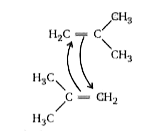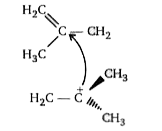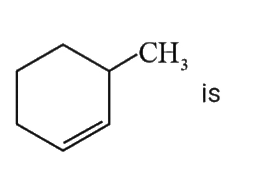2-Methylbutan-2-ol can be obtained by the acid catalyzed hydration of
CH3CH2CH=CH2
CH3CH=CHCH3
(CH3)2C=CHCH3
Either of the three
The correct Answer is:C
To solve the question regarding the synthesis of 2-Methylbutan-2-ol through acid-catalyzed hydration, we will follow these steps:
1. Identify the Target Compound:
We need to synthesize 2-Methylbutan-2-ol, which has the structure:
CH3C(OH)(CH3)CH2CH3
This indicates that the compound is a tertiary alcohol.
2. Understand Acid-Catalyzed Hydration:
Acid-catalyzed hydration of alkenes involves the addition of water (H₂O) across the double bond of an alkene in the presence of an acid. This process typically leads to the formation of an alcohol.
3. Analyze the Given Options:
We need to determine which alkene, when subjected to acid-catalyzed hydration, will yield 2-Methylbutan-2-ol.
4. Evaluate Each Option:
- Option A: CH3CH2C=CH2
- This compound, upon hydration, would form a secondary alcohol, not our target tertiary alcohol.
- Option B: CH3C=CHCH3
- This compound also leads to a secondary alcohol upon hydration, which is not the desired product.
- Option C: CH3C=C(CH3)CH2CH3
- This compound is a more complex alkene. When it undergoes hydration, it can form a tertiary carbocation, which is stable and will lead to the formation of 2-Methylbutan-2-ol.
5. Confirm the Mechanism:
- The double bond in Option C will attack a proton from the acid, forming a tertiary carbocation.
- Water will then attack this carbocation, leading to the formation of 2-Methylbutan-2-ol.
6. Conclusion:
Based on the analysis, Option C is the correct answer, as it leads to the formation of the desired tertiary alcohol.
Final Answer:
2-Methylbutan-2-ol can be obtained by the acid-catalyzed hydration of Option C.
---
We need to synthesize 2-Methylbutan-2-ol, which has the structure:
CH3C(OH)(CH3)CH2CH3
This indicates that the compound is a tertiary alcohol.
Acid-catalyzed hydration of alkenes involves the addition of water (H₂O) across the double bond of an alkene in the presence of an acid. This process typically leads to the formation of an alcohol.
We need to determine which alkene, when subjected to acid-catalyzed hydration, will yield 2-Methylbutan-2-ol.
- Option A: CH3CH2C=CH2
- This compound, upon hydration, would form a secondary alcohol, not our target tertiary alcohol.
- Option B: CH3C=CHCH3
- This compound also leads to a secondary alcohol upon hydration, which is not the desired product.
- Option C: CH3C=C(CH3)CH2CH3
- This compound is a more complex alkene. When it undergoes hydration, it can form a tertiary carbocation, which is stable and will lead to the formation of 2-Methylbutan-2-ol.
- The double bond in Option C will attack a proton from the acid, forming a tertiary carbocation.
- Water will then attack this carbocation, leading to the formation of 2-Methylbutan-2-ol.
Based on the analysis, Option C is the correct answer, as it leads to the formation of the desired tertiary alcohol.
2-Methylbutan-2-ol can be obtained by the acid-catalyzed hydration of Option C.
Similar Questions
Knowledge Check
2-Phenylbutan-2-ol can be prepared by which of the following combinations ?
AC6H5COCH3+C2H5MgBrBC2H5COCH3+C6H5MgBrCC6H5COC2H5+CH3MgBrDAll of theseWhich of the following best describes the flow of electrons in the acid-catalyzed dimerization of (CH3)2C=CH2 ?
A B
B C
C D
D
The major product obtained in the photo catalyzed bromination of 2-methylbutane is :
View SolutionWhich of the following intermediates are involved in the acid catalyzed esterification of carboxylic acid?
View SolutionButan-2-ol can be prepared from But-2-ene by
View SolutionThe major product formed when a 3-methyl butan-2-ol is heated with concentrated sulphiric acid, is :
View SolutionHydrogen chloride can be obtained by adding concentrated Sulphuric acid to:
View SolutionThe product of acid catalyzed hydration of 2−pheny1propene is
View Solution

